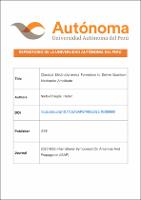| dc.contributor.author | Nieto-Chaupis, Huber | |
| dc.date.accessioned | 2024-04-05T14:16:29Z | |
| dc.date.available | 2024-04-05T14:16:29Z | |
| dc.date.issued | 2023 | |
| dc.identifier.uri | https://hdl.handle.net/20.500.13067/3084 | |
| dc.description.abstract | In some concrete examples such as the classical Compton backscattering, quantum mechanics phenomena can be also derived from rules given entirely inside the classical territory. In this paper the quantum mechanics amplitude and propagator were derived from classical electrodynamics without any condition of quantization. For this end the integer-order Bessel functions have been employed. In addition, the imaginary prescription encompassing the well-known quantum procedure is also derived. The results of this paper would corroborate the idea that classical formalisms are useful to attack problems as quantum mechanics does. | es_PE |
| dc.format | application/pdf | es_PE |
| dc.language.iso | eng | es_PE |
| dc.publisher | IEEE | es_PE |
| dc.rights | info:eu-repo/semantics/restrictedAccess | es_PE |
| dc.rights.uri | https://creativecommons.org/licenses/by-nc-nd/4.0/ | es_PE |
| dc.subject | Classical electrodynamics | es_PE |
| dc.subject | Compton | es_PE |
| dc.title | Classical Electrodynamics Formalism to Derive Quantum Mechanics Amplitude | es_PE |
| dc.type | info:eu-repo/semantics/article | es_PE |
| dc.identifier.journal | 2023 IEEE International Symposium On Antennas And Propagation (ISAP) | es_PE |
| dc.identifier.doi | https://doi.org/10.1109/ISAP57493.2023.10388680 | es_PE |
| dc.subject.ocde | https://purl.org/pe-repo/ocde/ford#2.02.04 | es_PE |


